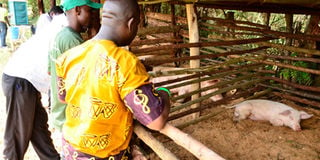Prime
What you ought to know about piggery

Participants checking out a sty during the Monitor Farm Clinic in September. PHOTO by ALEX ESAGALA
What you need to know:
- Experts advise farmers to maintain hygiene and avoid some diseases attacking their pigs, writes Esther Oluka.
Dr David Mutetikka, an associate professor of Animal Science at Makerere University, says when buying piglets or the adult pigs (boars and sows), one should not buy them because of their appearance.
“Do not buy the animal because it is big in size but rather choose basing on factors such as the litter size. If the piglet was born in a litter size of four, however good looking it is, there is a likelihood that it will maintain the same cycle and having the same number of piglets,” he said.
One should also buy piglets at eight weeks and feed them exclusively for four months until they weigh between 90 to 100kilogrammes.
During the growing stage, they should be eating about four kilogrammes of feed in order to gain one kilogramme of body weight on average.
Disease control
Workers managing the pigs should ensure they wear gumboots and overalls and change them before entering a sty if they had used the same in other places.
“One of the deadliest diseases we battle within pigs is African swine fever which neither has a cure or vaccine. Spreading it can be controlled if hygiene is observed,” Mutetikka said.
It is also important for farmers to stick to a particular deworming programme. The mature pigs should be dewormed twice a year while the growing ones every once in three months.
Profit
Sows should be able to give birth twice a year and should be pregnant again by the end of that year.
“Profit is determined by the number of piglets produced and those that survive to the market,” Mutetikka said.
Litter numbers should be 10 to 12 piglets “If the sow gives birth to a litter size of six piglets, there could be a problem of either the genetics of the sow or the farmer is not feeding them well,” Mutetikka said.
In addition, if one visited a farm and wanted to buy an already growing pig, they should look for one with a longer frame whose size will allow room for a lot of pork.
If one is keeping a boar, they should have a minimum of 10 females for reproduction because the cost of maintaining a boar is paid for by the piglets produced.
Challenges
Piggery, like any other projects has challenges. Expensive feeds which are sometimes of poor quality affects pigs. For instance, some maize bran supposed to be white in colour is sometimes brown.
In addition, customers always insist on buying at the lowest amount.
“The price they offer is usually less than what we have invested into the pig. You may price your pig at Shs160, 000 but the buyer insists on buying it at Shs120, 000,” he said.
Solutions
Mutetikka says government should set up an abattoir where farmers can deliver their pigs. “This makes it easy for us to set prices according to the conditions of production,” Mutetikka said.
He also advises farmers to observe what veterinary doctors do and learn so that they do not need to call them up every time there is a problem.




